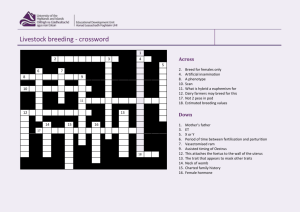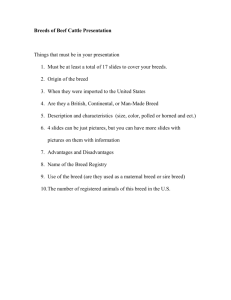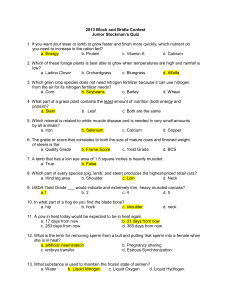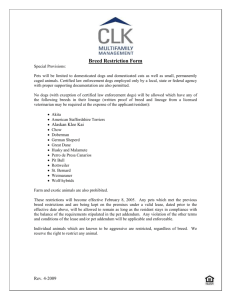EFFECT OF BREED FRACTION ON DAIRY TRAITS IN CATTLE
advertisement
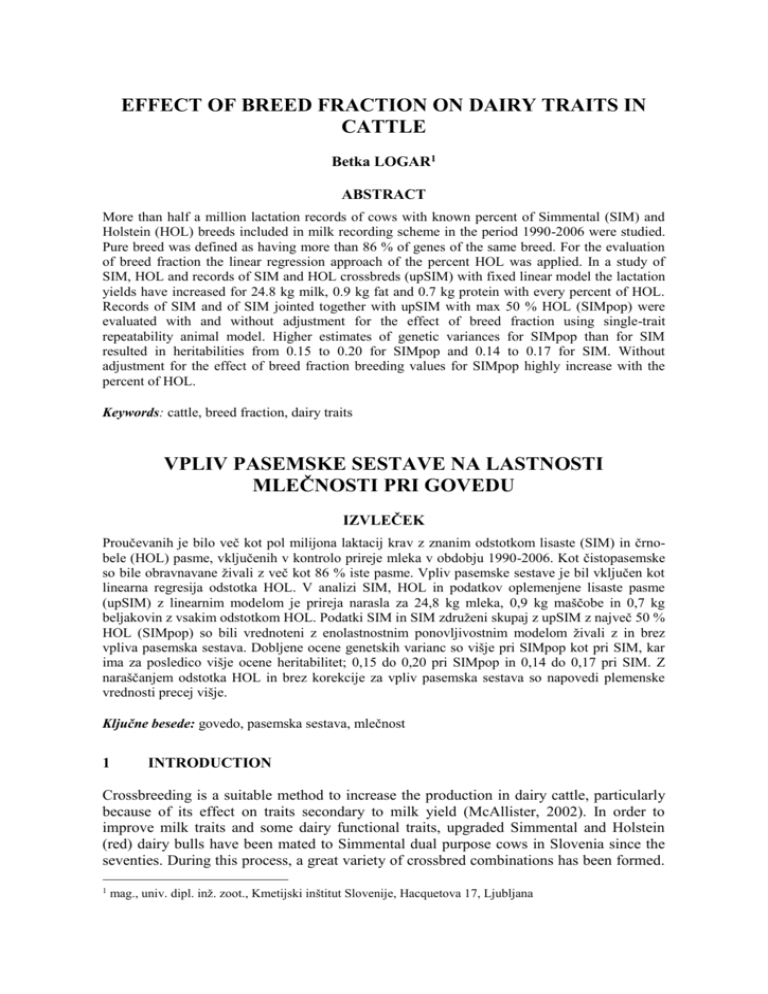
EFFECT OF BREED FRACTION ON DAIRY TRAITS IN CATTLE Betka LOGAR1 ABSTRACT More than half a million lactation records of cows with known percent of Simmental (SIM) and Holstein (HOL) breeds included in milk recording scheme in the period 1990-2006 were studied. Pure breed was defined as having more than 86 % of genes of the same breed. For the evaluation of breed fraction the linear regression approach of the percent HOL was applied. In a study of SIM, HOL and records of SIM and HOL crossbreds (upSIM) with fixed linear model the lactation yields have increased for 24.8 kg milk, 0.9 kg fat and 0.7 kg protein with every percent of HOL. Records of SIM and of SIM jointed together with upSIM with max 50 % HOL (SIMpop) were evaluated with and without adjustment for the effect of breed fraction using single-trait repeatability animal model. Higher estimates of genetic variances for SIMpop than for SIM resulted in heritabilities from 0.15 to 0.20 for SIMpop and 0.14 to 0.17 for SIM. Without adjustment for the effect of breed fraction breeding values for SIMpop highly increase with the percent of HOL. Keywords: cattle, breed fraction, dairy traits VPLIV PASEMSKE SESTAVE NA LASTNOSTI MLEČNOSTI PRI GOVEDU IZVLEČEK Proučevanih je bilo več kot pol milijona laktacij krav z znanim odstotkom lisaste (SIM) in črnobele (HOL) pasme, vključenih v kontrolo prireje mleka v obdobju 1990-2006. Kot čistopasemske so bile obravnavane živali z več kot 86 % iste pasme. Vpliv pasemske sestave je bil vključen kot linearna regresija odstotka HOL. V analizi SIM, HOL in podatkov oplemenjene lisaste pasme (upSIM) z linearnim modelom je prireja narasla za 24,8 kg mleka, 0,9 kg maščobe in 0,7 kg beljakovin z vsakim odstotkom HOL. Podatki SIM in SIM združeni skupaj z upSIM z največ 50 % HOL (SIMpop) so bili vrednoteni z enolastnostnim ponovljivostnim modelom živali z in brez vpliva pasemska sestava. Dobljene ocene genetskih varianc so višje pri SIMpop kot pri SIM, kar ima za posledico višje ocene heritabilitet; 0,15 do 0,20 pri SIMpop in 0,14 do 0,17 pri SIM. Z naraščanjem odstotka HOL in brez korekcije za vpliv pasemska sestava so napovedi plemenske vrednosti precej višje. Ključne besede: govedo, pasemska sestava, mlečnost 1 INTRODUCTION Crossbreeding is a suitable method to increase the production in dairy cattle, particularly because of its effect on traits secondary to milk yield (McAllister, 2002). In order to improve milk traits and some dairy functional traits, upgraded Simmental and Holstein (red) dairy bulls have been mated to Simmental dual purpose cows in Slovenia since the seventies. During this process, a great variety of crossbred combinations has been formed. 1 mag., univ. dipl. inž. zoot., Kmetijski inštitut Slovenije, Hacquetova 17, Ljubljana After the repeated number of matings the percentage of Holstein genes in Simmental breed increased and the upgraded animals represent 15 % of milk-recorded cows (Božič et al., 2009). Due to the skin color inheritance the upgraded animals were still red spotted and in many cases treated as Simmental animals without taking breed fraction into account. These animals were treated as purebred Simmental in the genetic evaluations as well. No breed fraction or other crossbreeding effects were taken into account, although it had an effect on the genetic evaluation (Harbers, 1997). Crossbreeding effects are included in the models for genetic evaluations of dairy traits in several countries (Interbull, 2000). The effect of breed fraction may have an impact on the prediction of breeding values for dairy traits in Slovenian Simmental population as well. The objective of this study was to asses the influence of breed fraction on milk yield traits in standard lactation and to evaluate the impact of breed fraction on the prediction of breeding values for Simmental breed. 2 MATERIAL AND METHODS For the investigation of the effect of the breed fraction on dairy traits the milk production records of Simmental and Holstein cows and their crossbreds were studied. First to fifth lactations starting with calvings in the period from 1990 to 2005 were included. The traits studied were: milk (kg), protein (kg), and fat (kg) yield in standard lactations (201 to 305day). Milk production data and pedigree information were collected from the database of Slovenian cattle recording scheme (Logar et al., 2005). Criteria for data inclusion were at least 60 kg protein and at least 60 kg fat yield, age at first calving within 17-48 months and age at calving within 17-110 months. Only data on animals with known birth date and breed fraction of Simmental and red or black Holstein were used. Breed fraction or proportion of different breeds was calculated from the original pedigree information for all animals included and for their ancestors as well, and ranged from 0 to 100 percents. Three related sets of data were analyzed. The first set comprised of two pure breeds (Simmental and Holstein) and their crossbreds. An animal was taken as purebred if 87 % or more of genes came from the same breed. Crossbred cows with 14 - 86% of Holstein breed were generally a result of upgrading with red Holstein. In the first data set (Tab. 1) a total of 504644 lactation records were included, 257562 of Simmental breed, 34423 of upgraded Simmental (14-86 % Holstein) and 212659 of Holstein. The number of records as well as the phenotypic mean and standard deviations for all traits and age at calving by breeds are given in Table 1 and by breeds and lactations in Table 2, all for the first set of data. Table 1: Means and standard deviations for milk yield, fat and protein yield and age at calving by breed Breed * HOL breed (%) SIM 0 - 13 SIM x HOL 14 - 86 HOL 87 - 100 Total No. of records Milk yield (kg) 257562 34423 212659 504644 4203 ± 1158 5120 ± 1492 6513 ± 1629 5239 ± 1785 * SIM-Simmental, HOL-Holstein; Fat yield (kg) Protein yield (kg) 173.8 ± 53.1 210.8 ± 63.5 262.9 ± 71.1 213.9 ± 75.4 139.8 ± 41.0 167.7 ± 50.0 210.3 ± 54.6 171.4 ± 58.6 Age at calving (month) 49.1 ± 18.7 45.7 ± 17.6 47.0 ± 17.6 48.0 ± 18.2 Table 2: Means and standard deviations for milk yield, fat and protein yield and age at calving by breed and lactation Breed * SIM SIM x HOL HOL LacNo. tation of records 1 74707 2 63053 3 51103 4 39373 5 29326 1 11989 2 9238 3 6247 4 4160 5 2789 1 71647 2 56009 3 40757 4 27317 5 16929 Milk yield (kg) 3855 ± 991 4190 ± 1150 4426 ± 1206 4451 ± 1210 4401 ± 1187 4748 ± 1283 5190 ± 1506 5471 ± 1591 5418 ± 1582 5259 ± 1562 5993 ± 1368 6571 ± 1652 6937 ± 1686 6927 ± 1700 6837 ± 1703 Fat yield (kg) 160.0 ± 46.1 174.3 ± 53.3 183.1 ± 55.8 182.7 ± 55.4 179.2 ± 53.9 196.4 ± 54.9 215.1 ± 64.0 225.1 ± 68.4 220.9 ± 67.8 262.9 ± 71.1 241.3 ± 59.1 266.8 ± 72.1 280.9 ± 74.8 278.8 ± 75.3 272.6 ± 74.9 Protein yield (kg) 127.6 ± 35.6 140.8 ± 41.3 147.3 ± 42.7 147.4 ± 42.5 145.0 ± 41.5 155.0 ± 43.7 172.1 ± 50.7 179.2 ± 53.1 176.2 ± 52.3 170.1 ± 51.0 192.6 ± 47.1 215.3 ± 55.3 223.7 ± 56.5 222.1 ± 56.2 217.9 ± 56.1 Age at calving (month) 28.3 ± 3.6 41.7 ± 4.5 55.0 ± 5.4 68.2 ± 6.2 81.5 ± 7.1 28.3 ± 3.7 41.6 ± 4.5 54.8 ± 5.3 68.0 ± 6.1 82.0 ± 6.9 29.0 ± 3.9 42.6 ± 4.7 55.8 ± 5.5 68.8 ± 6.3 81.6 ± 6.9 * SIM-Simmental, HOL-Holstein; all with the same % of HOL breed as in Table 1; Only purebred Simmental (SIM) records presented in Table 1 and Table 2 were included in the second data set. Jointly 257562 lactation records of SIM were obtained from 94302 cows in 8589 herds. Records included in the second data set and 27229 lactation records of upgraded Simmental cows with mostly 50 % of Holstein breed were included in the third data set. The highest percentage of Holstein breed in the third data set was thus 50 %, similar as in the national genetic evaluation for the Simmental breed. In the third data set is breed therefore named Simmental breed population (SIMpop). The SIMpop records were obtained from 104893 cows in 8865 herds. The number of records, the phenotypic mean and the standard deviation for all traits studied and the age at calving in the first to fifth lactation for SIMpop are given in table Table 3. Table 3: Means and standard deviations for milk yield, fat and protein yield and age at calving for Simmental breed population (SIMpop) by parities Breed * LacNo. tation of records SIMpop 1 83955 2 70281 3 56101 4 42793 5 31661 Total 1-5 284791 Milk yield (kg) 3928.8 ± 1037.1 4268.9 ± 1202.8 4498.6 ± 1255.7 4511.5 ± 1252.3 4450.3 ± 1222.5 4270.5 ± 1201.4 Fat yield (kg) 163.1 ± 47.6 177.6 ± 55.0 186.0 ± 57.4 185.1 ± 56.7 181.0 ± 55.0 176.5 ± 54.5 Protein yield Age at calving (kg) (month) 129.9 ± 36.8 28.3 ± 3.6 143.3 ± 42.7 41.7 ± 4.5 149.5 ± 44.0 55.0 ± 5.4 149.2 ± 43.5 68.2 ± 6.2 146.5 ± 42.3 81.5 ± 7.1 141.8 ± 42.2 48.8 ± 18.6 * SIMpop-Simmental and Simmental x Holstein; % HOL breed from 0 to 50 % The effect of breed fraction on dairy traits was initially studied on the first data set with records from Simmental and Holstein breeds and their crossbreds (Tab. 1). The percentage of Holstein breed in each cow was taken as an effect of breed fraction. Therefore, breed fraction represented an individual breed effect of Holstein breed. For the evaluation of effect of breed fraction linear regression approach was applied. Solutions in fixed linear model were obtained by PROC GLM of SAS (SAS Institute Inc. 2004). The following linear model was used: yijkl= µ + Gi+ Cj+ Sk + Ml + b1Aijkl + b2Aijkl2 + b3Lijkl + b4Bijkl + eijkl [1] where yijkl = observed value of the milk performance trait (milk, fat, protein yield in 201-305 days) of genotype i in lactation j that started with calving in the year k and month l; µ = overall mean; Gi = fixed effect genotype i (i = 1, 2, 3); Cj = fixed effect of lactation j (j = 1, 2, 3, 4, 5); Sk = fixed effect of calving year k (k = 1, 2, …, 16); Ml = fixed effect of month of calving l (l = 1, 2, …, 12); b1,b2 = linear and quadratic regression coefficients of dependent variable y on age at calving; A = continuous variable representing age at calving (in months); b3 = linear regression coefficient of dependent variable y on length of lactation; L = continuous variable representing length of lactation; b4 = linear regression coefficient of dependent variable y on breed fraction (% of Holstein); B = continuous variable representing breed fraction; eijkl = random residual. For further studies the second and the third data set were used. Univarate analyses were performed in the studies of effect of breed fraction on genetic and environmental parameters in SIM and in SIMpop. Genetic and other parameters were estimated using single-trait repeatability animal model with restricted maximum likelihood (REML) as applied in VCE-6 (Kovač et al., 2002). Two statistical models were used: model 2, where effect of breed fraction was included as linear regression and model 3 without the breed fraction effect. yjklmn= µ +Cj+ Sk + Ml + b1Ajkl + b2Ajkl2 + b3Ljkl + b4Bjkl + hm + pn + an + ejklmn [2] yjklmn= µ +Cj+ Sk + Ml + b1Ajkl + b2Ajkl2 + b3Ljkl + hm + pn + an + ejklmn [3] where the effects are as before in model 1 and: yjklmn = observed value of the milk performance trait (milk, fat, protein yield in 201-305 days) on animal n in lactation j that started with calving in year k and month l in herd m; hm= random effect of herd m; pn = random permanent environmental effect of cow n; an = random additive genetic effect of animal n; ejklmn = random residual. The direct additive genetic effect (an) was assumed to be normally distributed with mean zero and variance var a σ a2 A , where σ a2 is the direct additive genetic variance for the trait, and A is the additive relationship matrix. Other random effects were assumed to be normally distributed with mean zero as well. The variances are varh σ h2 I h and varp σ 2p I p , where σ h2 is herd and σ 2p is permanent environmental variance of the cow. Matrices Ih and Ip are the corresponding identity matrices. The residuals were assumed to be normally independent and identically distributed with mean zero and variances vare σ e2 I e . Heritability (h2) and repeatability (r) for each trait were calculated by the equations: h 3 2 σ a2 2 / σtotal and r σ a2 σ 2p 2 σ total 2 where σtotal σ a2 σ h2 σ 2p σe2 . RESULTS AND DISCUSSION Data from purebred and crossbred animals (Table 1, Table 2) was studied initially. All the effects included in the statistical model 1 for milk, fat and protein yield were found to be highly significant (P<0.001). The average phenotypic distances between pure breeds were 2310 kg for milk, 89.1 kg for fat and 70.5 kg for protein yield in 201-305 days of lactation (Tab. 1), while the crossbreds were placed between purebreds. By the model adjustment the lactation yield was increasing for 24.8 (± 0.29) kg of milk, 0.9 (± 0.01) kg of fat and 0.7 (± 0.01) kg of protein with every percent of Holstein breed. The phenotypic difference between pure breeds for milk yield was slightly lower than that estimated with the model (model 1). The differences in fat and protein yield are negligible. The results obtained indicated a significant difference in the production of Simmental and upgraded Simmental cows. Similar in the study Schichtl (2007) dairy production in crossbreds was higher than in Simmental and lower than in Holstein breed. The study was continued in the field of genetic evaluation. Purebred Simmental records (SIM, second data set) and purebred Simmental records joined together with records of upgraded Simmental cows (SIMpop, third data set) were evaluated using models 2 and 3. Estimates of variance components for SIM did not differ much between the statistical models (Tab. 4). The differences in estimates between the models were higher for SIMpop. Generally the estimated variance components were higher for SIMpop than for SIM. For all traits studied the genetic variances were higher in SIMpop than in SIM and increased for SIMpop in the model where breed fraction effect was excluded (model 3). Consequently, the estimates of heritability were higher for SIMpop than for SIM and higher for SIMpop if breed fraction effect was not included in the model. An increase of genetic variation in SIMpop was expected because of favorable effect of crossbreeding on increased genetic variation (Swan and Kinghorn, 1992; VanRaden, 1992). For all traits studied on both data sets a large amount of total variability of the traits was explained by the herd effect. Numerous herds with small number of observations per herd resulted in high variances of the herd effect. Estimates of repeatability range from 0.28 to 0.33. The estimated variance components presented in table 4 are in agreement with those used in the Slovenian national genetic evaluation of milk, fat and protein yield for Simmental breed (Description of … , 2007). On the base of estimated genetic and other parameters breeding values were predicted for SIMpop by statistical models 2 and 3. Differences in breeding values predicted with models 3 (no effect of breed fraction) and breeding values predicted with model 2 (effect of breed fraction included) for every particular animal were calculated. Additionally, linear regression of difference in breeding values on breed fraction was estimated. Differences in breeding values increased for 11.07 (± 0.0111) kg for milk, 0.45 (± 0.0006) kg for fat and 0.30 (± 0.0003) kg for protein yield with the percentage of breed fraction. That confirms expectations that purebred Simmental animals are in subordinate position if breed fraction effect is not taken into account. The contribution of breed fraction to the predicted breeding values is more clearly evident from averages of differences in breeding values by breed fraction (% of Holstein breed) presented in Figure 1. Animals with higher percentage of Holstein breed received higher predictions of breeding value when breed fraction effect was not included in the evaluation model. Likewise, in the study of (Harbers, 1997) the breeding values changed after the inclusion of correction for effect of crossbreeding in the statistical model for milk production. Similar as in our study, with animals where correction had no effect, no differences in breeding values were found. Table 4: Estimates of additive genetic ( σ a2 ), herd ( σ h2 ), permanent environmental ( σ 2p ), residual variance ( σ e2 ), heritability (h2) with standard errors (se), and repeatability (r) for milk, protein, and fat yield by statistical models for Simmental breed (SIM) and Simmental breed population (SIMpop) Trait/Estimates σ a2 σ h2 σ 2p σ e2 h 2 se r Model 2 Breed Milk Fat Protein 156218 260.8 148.2 333444 637.7 461.5 130212 258.2 155.7 Milk Fat Protein 176779 291.8 167.1 350373 660.5 481.4 130864 259.2 156.5 Model 3 Breed Milk Fat Protein 157070 262.0 148.6 333674 638.3 461.8 129875 257.8 155.6 Milk Fat Protein 199423 333.7 186.9 355236 668.3 486.8 120032 238.5 146.7 SIM 290818 0.17 ± 0.0048 650.4 0.14 ± 0.0047 331.2 0.14 ± 0.0043 SIMpop 300198 0.18 ± 0.0046 665.7 0.16 ± 0.0043 339.1 0.15 ± 0.0042 SIM 0.17 ± 0.0048 0.14 ± 0.0047 0.14 ± 0.0043 SIMpop 300127 0.20 ± 0.0042 665.6 0.18 ± 0.0041 339.1 0.16 ± 0.0041 290808 650.4 331.2 0.31 0.29 0.28 0.32 0.29 0.28 0.31 0.29 0.28 0.33 0.30 0.29 The results obtained indicated that breed fraction has an effect on predicted breeding values for SIMpop and consequently, that in the evaluation of upgraded Simmental population at least breed fraction has to be taken into account. Treating of upgraded animals as purebred has negative influence on the selection in Simmental breed. Upgraded animals are therefore receiving higher genetic value and thus have higher chance to be selected than the purebred ones. There are many benefits of crossbreeding and upgrading. But it has to be realized that in crossbreeding scheme genetic improvement is based on the performance of purebred animals and we then utilize improved animals in crossbreeding schemes (Roughsedge and Simm, 2002). Therefore, reliable evaluation is needed that would provide useful information and aid the breeders with the selection of proper animals. Possible solution is to find specific model for a joint evaluation of purebred and crossbreed records as in VanRaden et al. (2007). Figure 1: Average difference in breeding values (BV) predicted with two models (without or with the effect of breed fraction) regarding to Holstein (HOL) breed fraction for milk, fat and protein yield The records of crossbred dairy cattle need to be adjusted for crossbreeding effects (Harbers, 1997; VanRaden and Sanders, 2003). An important and extensive part of this study was finding and calculation of breed fractions, which enabled further research. The unique identification of animals including breed fraction permits the use of production data in order to estimate additive and non-additive genetic parameters (McAllister, 2002). With less systematic crossbreeding, estimation of crossbreeding effect is difficult to determine (Van Vleck, 1997). Simplification of estimation of crossbreeding effects was made in the study. Only the breed fraction effect of Holstein as an individual breed effect on dairy traits was studied. In this way further investigation for the estimation of a specific crossbreeding effect will be needed. Other traits of importance should also be investigated. Therefore, the study needs to be continued to find suitable solution for accurate prediction of genetic value for SIMpop. 4 CONCLUSIONS Summarizing the results and the discussion, the significant effect of breed fraction on milk, fat and protein yield was observed. The breed fraction effect should be taken into account in the genetic evaluation for Simmental breed where population consists of pure breed and upgradeed animals. Further investigation to find a suitable solution for accurate prediction of genetic value for SIMpop is therefore necessary. 5 REFERENCES Božič, A., Jenko, J., Sadar, M., Jeretina, J., Logar, B., Perpar, T., Podgoršek, P., Žabjek, A., Glad, J., Ivanovič, B. 2009. Rezultati kontrole prireje mleka in mesa : Slovenija 2008 (A. Božič, Ed.). Ljubljana: Kmetijski inštitut Slovenije, Govedorejska služba Slovenije. Description of national genetic evaluation system: Slovenia. 1997. Klemen Potočnij, Jurij Kersnik (27.2.2007). http://www-interbull.slu.se/national_ges_info2/framesida-ges.htm (19. 6.2010). Harbers, A.G.F. 1997. The usage of heterosis correction in a multiple breed genetic evaluation. Proceedings of the 1997 Interbull meeting, Vienna. Interbull meeting Vienna 16, Uppsala, International bull evaluation service. 89-93. Interbull. 2000. National genetic evaluation programs for dairy production traits practiced in Interbull member countries. Interbull Bulletin 24. International Bull Evaluation Service, SLU, Uppsala, International bull evaluation service. Kovač, M., Groeneveld, E., García-Cortés, L.A. 2002. VCE-5, a package for the estimation of dispersion parameters. Proceedings of the 7th World Congress on Genetics Applied to Livestock Production, Montpellier, France. 7th World Congress on Genetics Applied to Livestock Production. 28. Logar, B., Podgoršek, P., Jeretina, J., Ivanovič, B., Perpar, T. 2005. Online-available milkrecording data for efficient support of farm management. In: A. Kuipers, M. Klopčič, and T. Cled (Eds.) Knowledge transfer in cattle husbandry : new management practices, attitudes and adaptation. Wageningen Academic Publishers, Wageningen: 227-230. McAllister, A.J. 2002. Is crossbreeding the answer to questions of dairy breed utilization? . Journal of Dairy Science. 85 9, 2352-2357. Roughsedge, T., Simm, G. 2002. The genetic basis of crossbreeding and some applications in beef cattle breeding. 53rd Annual Meeting of European Association for Animal Production , 15 p. Schichtl, V. 2007. Einfluss der Kreuzung von Deutschen Holsteins und Deutschem Fleckvieh auf Milchleistung, Milchqualität und allgemeine gesundheitsmerkmale in einem automatischen Melksystem. Dissertation: Tierärztlichen Fakultät der Ludwig-Maximilians-Universität München, 161 p. Swan, A. A., Kinghorn, B.P. 1992. Evaluation and exploitation of crossbreeding in dairy cattle. Journal of Dairy Science 75 2, 624-639. Van Vleck , L.D. 1997. Calculation of breed direct and maternal genetic fractions and breed specific direct and maternal heterozygosity for crossbreeding data. Brazilian Journal of Genetics 20. VanRaden, P.M. 1992. Accounting for Inbreeding and Crossbreeding in Genetic Evaluation of Large Populations. Journal of Dairy Science 75, 11, 3136-3144. VanRaden, P.M., Sanders, A. H. 2003. Economic Merit of Crossbred and Purebred US Dairy Cattle. Journal of Dairy Science 86 3, 1036-1044. VanRaden, P.M., Tooker, M.E., Cole, J.B., Wiggans, G.R., Megonigal, J.H. Jr. 2007. Genetic Evaluations for Mixed-Breed Populations. Journal of Dairy Science 90. 2434-2441.
